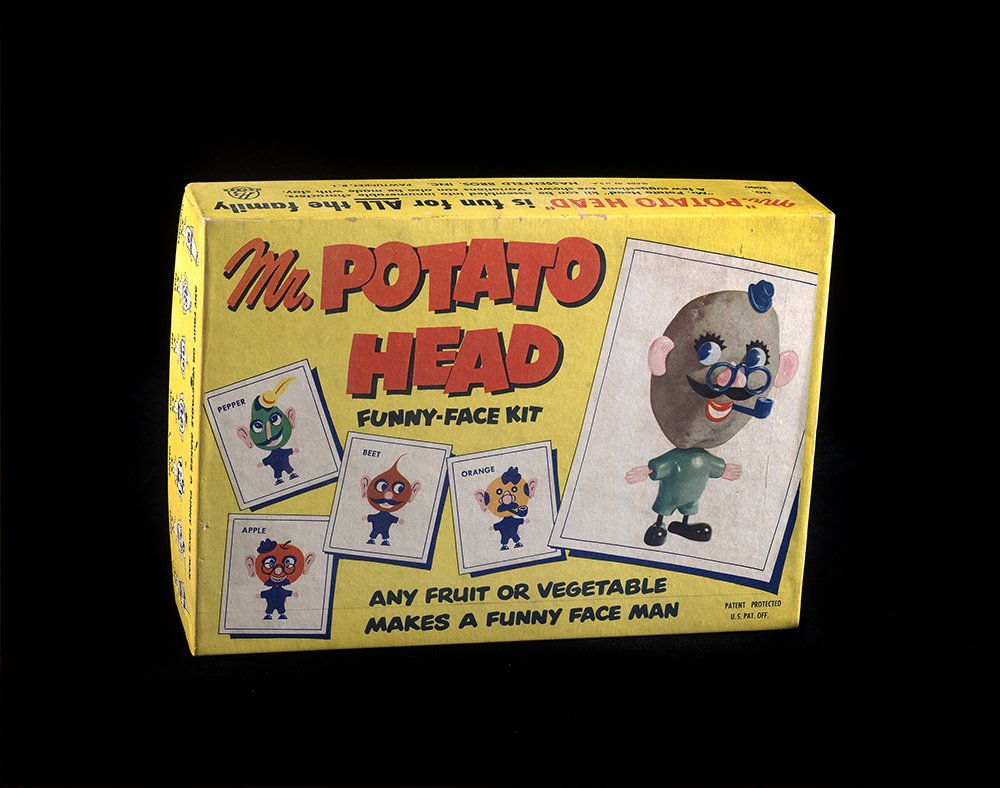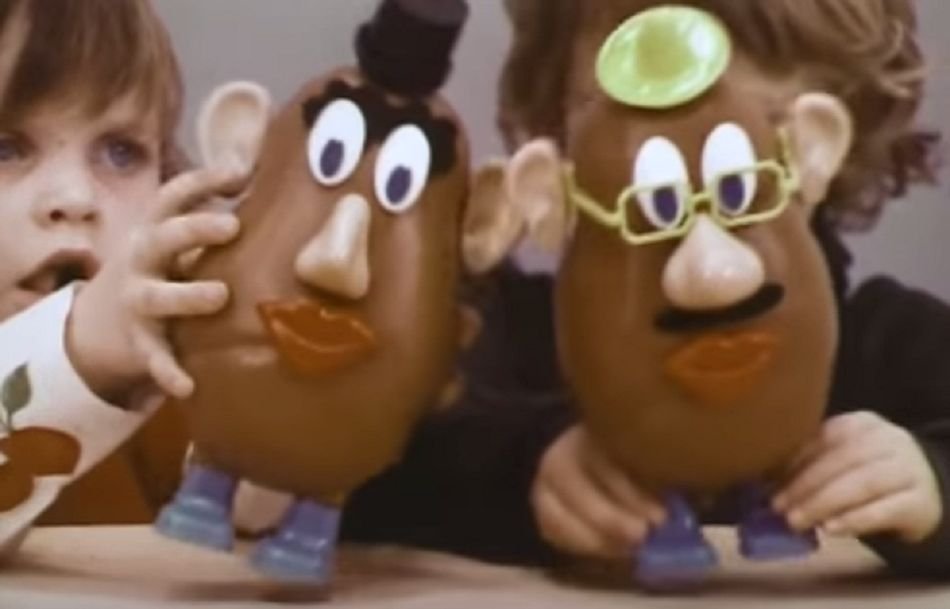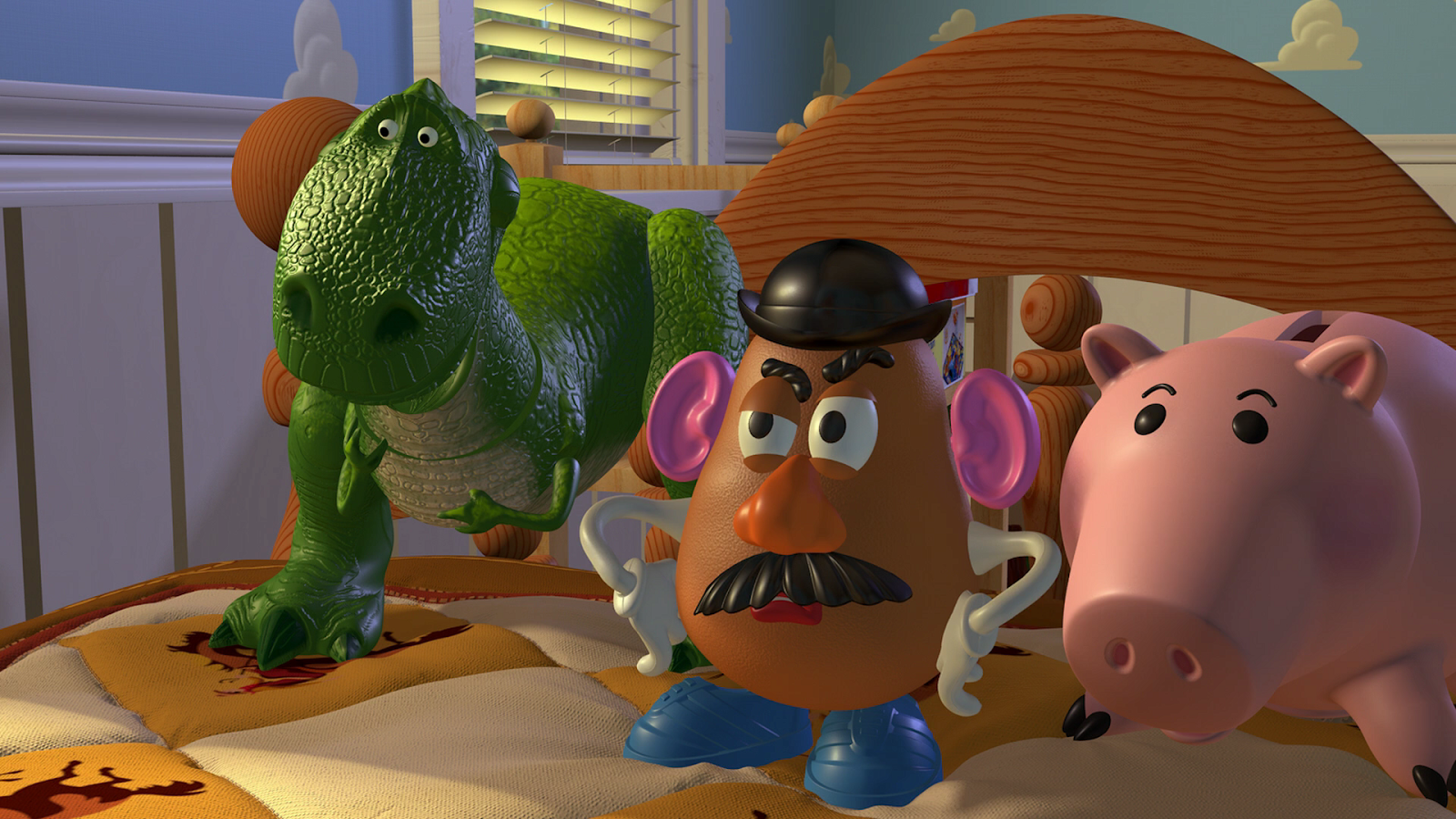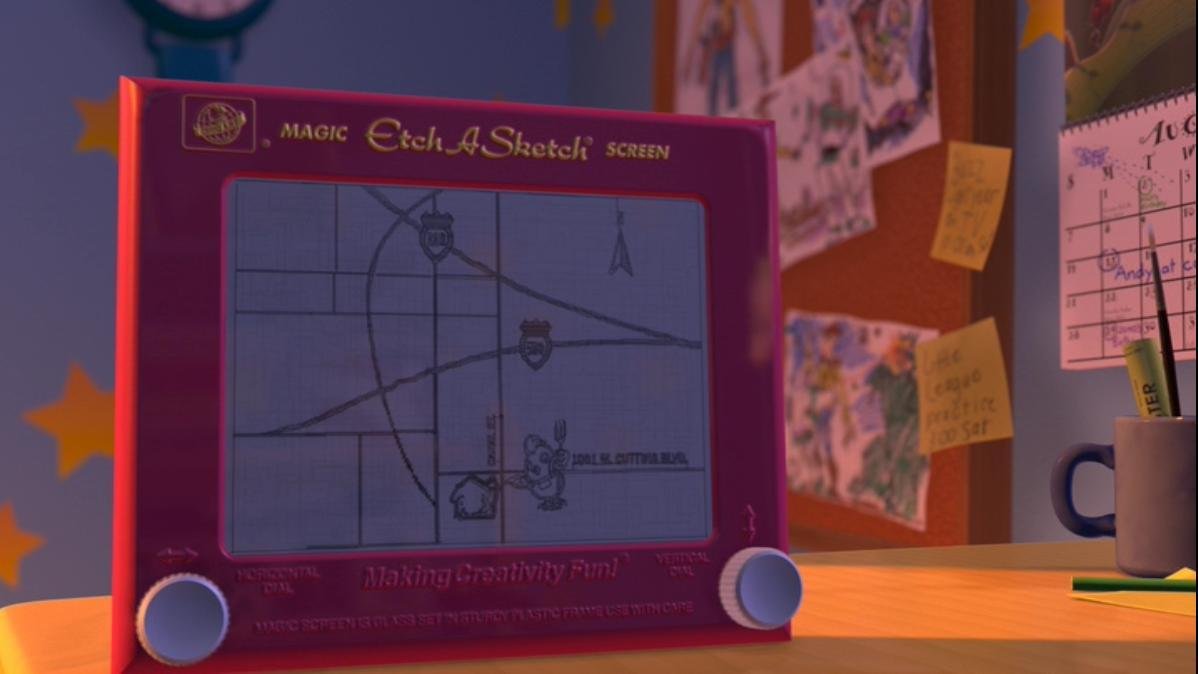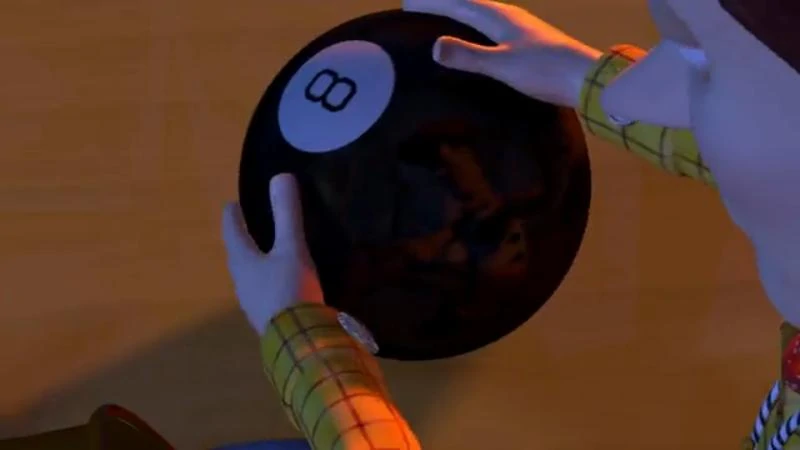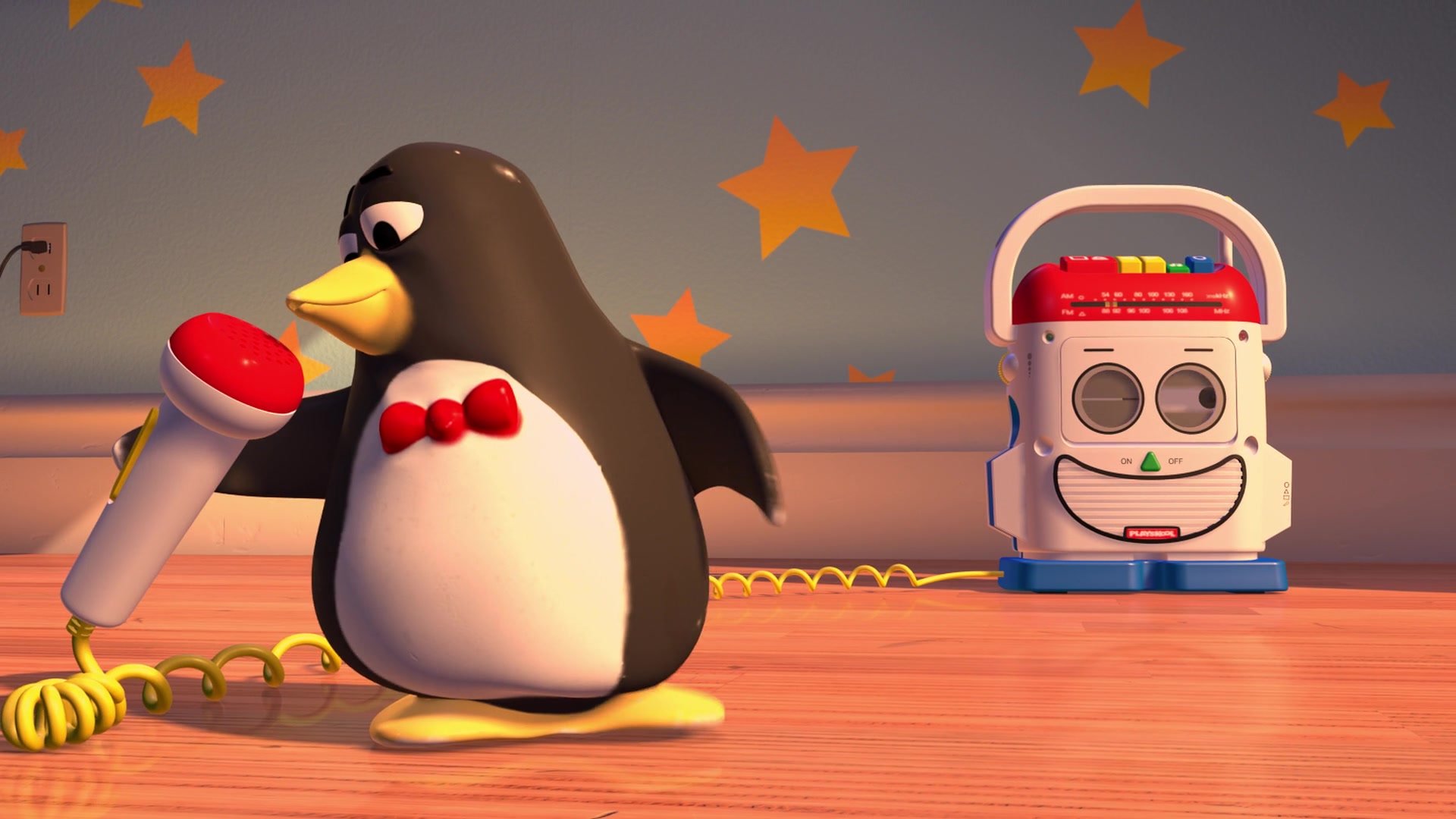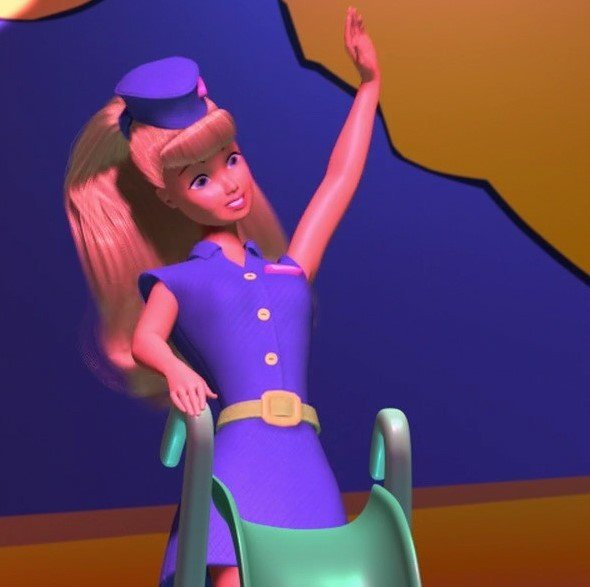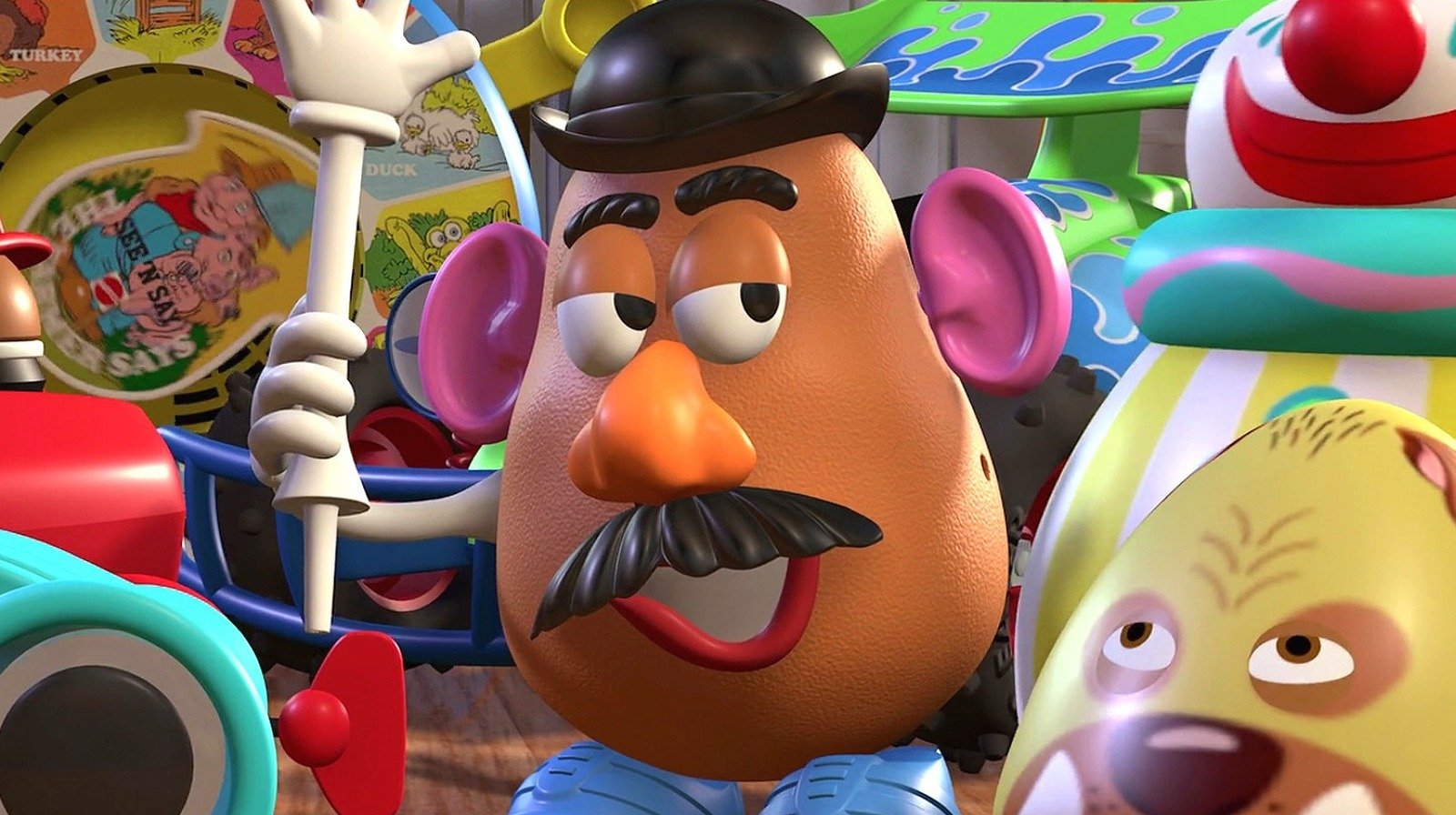The Real Toys of Toy Story (1995)
Who remembers going to McDonald’s and getting a happy meal just for the toy? Or opening your favourite box of cereal in the morning and digging for the surprise toy, DVD, or computer game at the bottom? The 1990s was notorious for having some of the best toys, so it was a no brainer for Pixar’s first movie to feature some of the audience’s favourite nostalgic toys. Though many of the gang were made up for the movie (like our 2 main friends, Woody and Buzz), a lot of Andy’s toys are replicas or inspired by toys that exist or once existed in real life. Toy Story is based in its present time, 1995, so many of Andy’s toys pre-date the movie. Let’s take a look at some of the real toys of Toy Story.
Mr. Potato Head
The Mr. Potato Head toy can be traced back all the way to 1949. George Lerner, an artist from New York, wanted to find a way to make eating fruits and vegetables more appealing to children. He began experimenting with plastics, and eventually created plastic push pin figures that were in the shape of different facial parts, like eyes, noses, mouths, ears. The idea didn’t take off in the toy market right away due to the lack of food resources in the post-war age, but he did ultimately end up selling the toy to Hasbro in the early 1950s, and by 1952, these plastic parts were being sold in America. Other parts were developed as well, including arms, feet, and various accessories. After about a decade of trials and sales, complaints began to arise from consumers and food regulators that mixing food and play together wasn’t sustainable. In 1964, Mr. Potato Head received his full form, with the plastic parts and plastic potato being sold together.
Original Mr. Potato Head toy. Image from: https://www.heinzhistorycenter.org/blog/collection-spotlight/mr-potato-head-funny-face-kit
Not only was this the first toy of its kind, the Mr. Potato Head toy also paved the way for toy and children’s commercials on television. It was the first toy ever to be advertised on TV in 1952, and the first commercial to be directly targeted to children, which was not a common practice before that time. He also became a bit of a political figure, participating in anti-smoking campaigns in 1987 when they stopped selling his pipe accessory, in 1992 when he received the Presidential Sports Award after giving up the “couch potato” reputation, and when he received 4 mail-in votes to become the Mayor of Boise, Idaho in 1985.
Hasbro commercial for the Potato Heads in the 1970s. Image from: https://www.shared.com/12-things-you-may-not-have-realized-about-mr-potato-head/
Mrs. Potato Head was introduced in 1953, the year after his first distribution, and Brother Spud and Sister Yam followed shortly after. Mr. Potato Head was inducted in the National Toy Hall of Fame in 2000.
Rex, Mr. Potato Head, and Hamm in Toy Story. Image from: http://themovieman-bennyjayruss.blogspot.com/2013/05/toy-story-1995.html
Slinky Dog
Much like many other toy creations in the early 1900s, the slinky toy had many different iterations and progressions. The first metal slinky was invented in 1943 by American naval engineer Richard T. James while developing a new type of spring. It hit the toy market in 1945 with 400 in stock to sell, and was an instant success. The price was $1 at the time, and after its first 10 years in the business, 100 million slinky toys were sold to loving Americans everywhere. The company saw a bit of a decline before 1960, and that year Richard and his wife Betty founded James Industries, to expand their market and discover new iterations of the invention.
Slinky toy in the newspaper. Image from: https://clickamericana.com/toys-and-games/original-slinky-slinky-seal-slinky-dog-more-1957
Slinky Dog made its debut in 1952, as the first iteration of the slinky. Slinky Worm Suzie, Slinky Train Loco and Slinky Crazy Eyes followed shortly after. The idea of the Slinky Dog was conjured up by American toy inventor Helen Herrick Malsed, who had the idea of attaching a dogs head and behind to the ends of the slinky contraption. James Industries began manufacturing these toys which also were an instant hit, and paid royalties to Malsed each year for 17 years for coming up with the idea.
Slinky Dog in the newspaper. Image from: https://clickamericana.com/toys-and-games/original-slinky-slinky-seal-slinky-dog-more-1957
Richard James left his wife and children before dying at the age of 56 in 1974. Much of the success of the company fell on Betty James, who kept the company alive until it was sold in 1998. She is notably the one who named the toy “slinky” as well. She was around for the release of the first 2 Toy Story movies, and was approached by Pixar whom asked for permission to feature the toy in the film. The Slinky Dog has been out of production for a few years before the film, and after our beloved, loyal pal Slink joined the gang, 825,000 units of Slinky Dogs sold.
Betty James died in 2008. The Slinky toy and Betty James were inducted into the Toy Industry Association’s Hall of Fame in 2001.
Betty James. Image from: https://www.terryclark.com/journal/2018/3/10/betty-james-and-the-slinky
Slinky Dog in Toy Story. Image from: https://celebrationspress.com/2018/07/01/six-things-you-may-not-know-about-slinky-dog/
Green Army Men
The presence of little toy army men can be traced back to the 1930s. They were originally made of metals and glue and sawdust, distributed by Bergen Toy and Novelty Co. in 1938. The soldiers were posed in such ways that mid-20th century soldiers would be in real life, running, holding rifles, playing a trumpet, and looking through binoculars. They were sold in bulk, as they always have been, and you could pick them up in various department stores and markets. The materials used to make these toys changed in the 1950s and they began using soft plastic made of polyethylene. Other competing toy companies began manufacturing very similar wartime toys, but they all took a hit through the 60s and 70s due to the Vietnam War. The appeal of the army men declined, and Bergen Toy and Novelty Co. had sold its molds to Banner Plastics just before 1960.
Toy soldiers. Image from: https://www.wikiwand.com/en/Toy_soldier
Toy Story acted as the revival of the green army men. In 1980, they started to be sold in buckets, which is shown in the movie as they hop out of a red and white bucket with the phrase “Bucket O Soldiers” written on it. This boosted the interest in the toys once again, and the popularity shot back up through the end of the 1990s and the early 2000s. The troops were inducted into the National Toy Hall of Fame in 2014.
Bucket O Soldiers from Toy Story. Image from: https://thehobbeehive.com/2016/11/17/15-fun-facts-about-the-toy-story-franchise/
Barrel of Monkeys
A classic 1960s toy, the Barrel of Monkeys were manufactured by Lakeside Toys in 1965. The monkey could be removed from the barrel and separated to be played with individually, or if the child wanted to use them as intended, they would use just one monkey to hook all of the other monkeys together by the arms. This idea was dreamed up by Milton Dinhofer and Leonard Marks, who found fascination and entertainment in linking chains together. Milton thought of making monkeys the links, red ones, that would hook on by the arms. They made the first sample which included 12 monkeys, red, green and yellow, and was originally called “Chimp to Chimp”. Marks and Dinhofer attempted to work toward selling their new creation, but after some failed attempts to get them on shelves and not enough resources to get them on television sets, their partnership and Chimp to Chimp ended. In 1965, Dinhofer found out that Marks and his new partner Herman Kesler, had brought the molds and the idea of the monkeys to Lakeside Toys, who then sold the idea of the Barrel of Monkeys. Barrel of Monkeys is now owned by Hasbro.
Barrel of Monkeys. Image from: https://toytales.ca/barrel-of-monkeys-from-lakeside-toys-1965/
Etch A Sketch
The little red framed drawing toy has been one of the most beloved toys of all time. It was started by French electrician Andre Cassagnes, who discovered that he could see pencil marks on a translucent decal while working on a factory light switch plate. The very first prototype of the toy is very similar to the way it ultimately ended up, which is extremely impressive for a man who had no history in toy making before. He used a hollow box, glass, aluminum powder, and a joystick with a pulley system attached to create his new invention. Andre partnered with Paul Chaze, and patented the toy under their accountants name, Arthur Granjean. The Ohio Art Company then acquired Etch A Sketch from Cassagnes for $25,000, but they continued to work together with Cassagnes to perfect the design to put it in the shelves and in the homes of American families in the 60s. They made the toy resemble a television set, which ended up working out perfectly given that the sales from commercials really shot this toy up into stardom. The glass in the toy was replaced with plastic in 1969. Sales saw a major decline before the release of Toy Story in 1995, and though Etch’s scene did boost sales temporarily, they did decline again before 1999. Toy Story 2 is what held the fate of Etch A Sketch together, as its longer scene in relation to Al’s Toy Barn really lifted the toy from being almost pulled off the shelves for good, to adding a 20% increase in sales.
Etch was inducted into the National Toy Hall of Fame in 1998 and was named one of the 100 most memorable toys of the 20th century.
Etch-A-Sketch in Toy Story. Image from: https://disney-hiddensecrets.tumblr.com/post/1667873580/when-the-toys-are-planning-the-rescue-of-woody
Toddle Tots by Little Tikes
In 1970, a man named Thomas G. Murdough founded the brand Little Tikes, to build children’s play outdoor equipment such as slides, cars, sandboxes, and more. He had 9 employees on his side at the time and they began manufacturing in Ohio. His goal was to make durable plastic products that wouldn’t break down as quickly as other plastic toys at the time. The launch was an instant hit, and in just 10 years, the company had made $15 million in sales, and more than doubled their profits in the next 10 years. In 1979, they introduced the Cozy-Coupe car, which was and is still one of their most popular products. The brand became very well-liked by parents everywhere, as they made a point to mold a toll-free customer service number into the toys themselves, which stood out from any other toy around at that time.
Toddle Tots by Little Tikes. Image from: https://www.ebay.com/itm/294792778526
In 1984, Murdough sold the company to Rubbermaid for $50 million but continued to stay on until 1989. In 1986, Little Tikes introduced Toddle Tots, little round “people” with different outfits that could fit into their own vehicles. In Toy Story, the 1988 set 0671 of the Toddle Tots is featured, which is 4 firefighters, a dog, and a firetruck. The Sailor Tike was also one that existed in real life, but the rest of the Tikes were made up for the film. These toys definitely didn’t need the help of an animated children’s movie to make sales, but by 1995, Little Tikes had made $400 million.
Magic 8 Ball
The origins of the Magic 8 Ball could not be more magical and more fitting for the toy. Albert C. Carter, son of psychic Mary, was fascinated by the supernatural and psychology. He grew up watching his mother perform fortune telling and psycho-slate, which was when she asked the spirits for an answer on a chalkboard and the answer would magically appear. Albert wanted to create his own device that would do something similar and you could ask any possible question to. Carter’s first prototype in 1944 was called the Syco-Seer, which involved two dice with words on them and a tube of liquid, and when the tube was rotated with one side up, a side of the die would appear upright. Carter teamed up with Abe Bookman and they create Alabe Crafts Inc. to sell the Syco-Seer to families everywhere. In 1948, Carter passed away, and Bookman continued the journey of redesigning the product to make it more appealing. It caught the attention of Brunswick Billiards, who was looking to do a giveaway. Bookman jumped at the opportunity and redesigned it into a Magic 8 Ball to fit the theme of the giveaway, and stuck with the design thereafter. It had 10 positive answers, 5 negative answers, and 5 inconclusive answers.
The Magic 8 Ball is now owned by Mattel.
The Magic 8 Ball in Toy Story. Image from: https://www.reddit.com/r/shittymoviedetails/comments/f7hu8m/in_toy_story_1995_woody_asks_the_magic_8_ball_a/
Speak & Spell
Mr. Spell, our underdog hero of Toy Story 2 that helps Buzz figure out Woody is at Al’s Toy Barn, is based on a 1970s educational aide toy called the Speak & Spell. It was first developed by Texas Instruments, and first hit the market in 1978 at the Summer Consumer Electronics Show. Texas Instruments had been looking into synthetic speech, which was a way to have electronics speak back to you after typing in a word (like Siri). The Speak & Spell was the first technology of its kind to use DSP technology, which is digital signal processing. Sounds were converted into a digital form, which would be useful for children who are just learning to pronounce words and spell. 4 men worked on the development of this new creation, Paul Breedlove, Gene Frantz, Larrey Brantingham, and Richard Wiggins with a $25,000 budget. This educational toy was revolutionary at the time, and paved the way for many other modern day technologies that use text to speech and memory.
See n’ Say
See n’ Say was yet another children’s educational tool created in 1965 that had the ability to speak back to its owner. The See n’ Say was developed by Mattel, after they saw the success of pull-string dolls and wanted to give children the opportunity to choose their own sounds that the toy would make. Like the version we see in Toy Story which was based off of a 1989 model, the Farmer model was one of the most popular, and had animal sounds of ducks, chickens, sheeps, pigs, cows, and more. Other versions like music ones, Disney ones, Peanuts ones, Dr. Seuss ones, and more were made as the idea was so adaptable. See n’ Says are still sold today by Mattel.
See n’ Say. Image from: http://www.danthepixarfan.com/2015/02/toy-story-see-n-say.html
Troikas
Troikas in Toy Story. Image from: https://pixarpages.wiki/pt/personagens/troikas
The Troikas in Toy Story are a combination of 2 real life figures, the Matryoshka Dolls (or Russian nesting dolls) and the Little Tikes Nesting Farm Animals toy. Matryoshka Dolls can be traced all the way back to 1890 by wood carver Vasily Zvyozdochkin and designer Sergey Malyutin. The original version had 8 total dolls, with the outer and biggest one being modeled after a “mother” in traditional Russian clothing. The dolls inside of her, continually getting smaller, would be her '“children”. The Little Tikes Nesting Farm Animals follow this format, with 5 different animals: a cow, sheep, pig, rooster, and a mouse. The Troikas in Toy Story are also animals: a dog, cat, duck, fish, and ladybug.
Troll Dolls
Though Troll Dolls have seen MASSIVE success, they had humble beginnings. Denmark baker Thomas Dam carved the first troll dolls out of wood by the fireplace when trying to find things to entertain children. Dam couldn’t afford to buy real toys after his bakery had shut down and Denmark was feeling the affects of WWII. He went door to door to sell these little wooden dolls and did very well doing so, and in the 1950s he ventured into full time toy making. He had been asked to carve a large Santa Claus sculpture for a local department store, and on top of that, he created little elves for the window display. The elves were a big hit with consumers who wanted their own. As demand grew, Dam opened up his own factory, and started making them out of PVC plastic.
In 1962, Troll Dolls were dominating the toy market, along with the various accessories for them too. They made their way to the US market, with the approval of President Kennedy who was photographed with Betty Miller holding her troll doll. There was a boom for troll dolls in the 1990s, so it’s no surprise that Pixar wanted to feature them in their movie. The toy dolls are still highly popular today after the release of Dreamworks Trolls.
Troll dolls. Image from: https://www.smithsonianmag.com/innovation/colorful-history-troll-doll-180974634/
Honourable Mention: Mr. Mike by Playskool
Although the Mr. Mike toy was developed after Toy Story, he is based on Playskool’s Rockin’ Robot toy that was an AM/FM radio and cassette player!
Wheezy and Mr. Mike. Image from: https://productplacementblog.com/cartoons-and-animation-movies/playskool-mr-mike-voice-changer-tape-recorder-in-toy-story-2-1999/
Reference list:
https://pixar.fandom.com/wiki/Andy%27s_Toys#In_Toy_Story
https://en.wikipedia.org/wiki/Mr._Potato_Head
https://newsroom.hasbro.com/static-files/ac8a4571-9ede-45f4-a27b-403edcd1fb3c
https://en.wikipedia.org/wiki/Slinky#Slinky_Dog
https://en.wikipedia.org/wiki/Betty_James
https://celebrationspress.com/2018/07/01/six-things-you-may-not-know-about-slinky-dog/
https://www.plasticstoday.com/consumer-products/how-little-green-army-men-marched-history
http://content.time.com/time/specials/packages/article/0,28804,2049243_2048656_2049099,00.html
https://www.techtimes.com/articles/67257/20150710/etch-a-sketch-history.htm
https://en.wikipedia.org/wiki/Etch_A_Sketch#History
https://www.referenceforbusiness.com/history2/92/Little-Tikes-Company.html
https://www.mentalfloss.com/article/67702/brief-history-magic-8-ball
https://en.wikipedia.org/wiki/Magic_8_Ball#Live-action_film_adaptation
https://www.thoughtco.com/what-is-a-speak-and-spell-1992413
https://en.wikipedia.org/wiki/See_%27n_Say
https://pixar.fandom.com/wiki/See_'n_Say?so=search
https://pixar.fandom.com/wiki/Troikas
https://en.wikipedia.org/wiki/Matryoshka_doll
https://www.worthpoint.com/worthopedia/little-tikes-barnyard-farm-animals-1835978684
https://www.smithsonianmag.com/innovation/colorful-history-troll-doll-180974634/
https://www.retrothing.com/2012/01/playskool-rockin-robot-the-grinning-cassette-recorder.html
